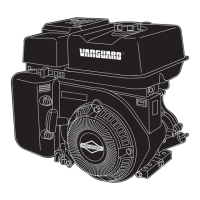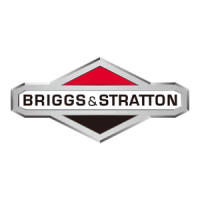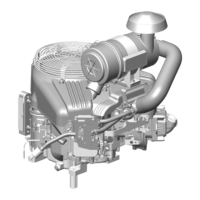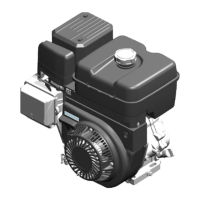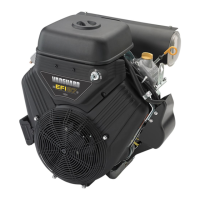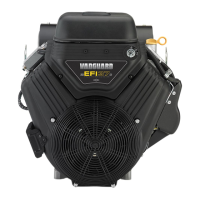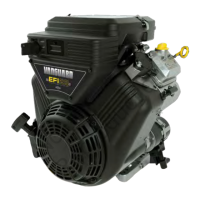GB
GB
1
Note: (This note applies only to engines used in the U.S.A.) Maintenance, replacement or repair of the emission control devices and systems may be performed
by any nonroad engine repair establishment or individual. However, to obtain no charge repairs under the terms and provisions of the Briggs & Stratton
warranty statement, any service or emission control part repair or replacement must be performed by a factory authorized dealer.
- refer to engine components in figure .
19
How To Use Manual Figures
- refer to figures inside covers.
- refer to part/action in figures.
1
Record your engine Model, Type and Code numbers
here for future use.
Record your date of purchase here for future use.
In the state of California, Model Series 50000, 85400,
86400, 115400, 117400, 118400, 138400 engines are
certified by the California Air Resources Board to meet
emissions standards for 125 hours; Model Series
184400, 185400, 235400, 245400 for 250 hours. Such
certification does not grant the purchaser, owner or
operator of this engine any additional warranties with
respect to the performance or operational life of this
engine. This engine is warranted solely according to
the product and emissions warranties stated elseĆ
where in this manual.
Technical Information
Power Ratings
The power ratings for an individual engine model are initially
developed by starting with SAE (Society of Automotive
Engineers) code J1940 (Small Engine Power & Torque Rating
Procedure) (Revision 2002Ć05). Given both the wide array of
products on which our engines are placed, and the variety of
environmental issues applicable to operating the equipment, it
may be that the engine you have purchased will not develop
the rated horsepower when used in a piece of power
equipment (actual onĆsite" power). This difference is due to a
variety of factors including, but not limited to, the following:
differences in altitude, temperature, barometric pressure,
humidity, fuel, engine lubrication, maximum governed engine
speed, individual engine to engine variability, design of the
particular piece of power equipment, the manner in which the
engine is operated, engine runĆin to reduce friction and clean
out of combustion chambers, adjustments to the valves and
carburetor, and other factors. The power ratings may also be
adjusted based on comparisons to other similar engines
utilized in similar applications, and will therefore not necessariĆ
ly match the values derived using the foregoing codes.
Engine Components (see fig. )
1
Fuel shutĆoff valve
2
Rope handle
3
Air cleaner
4
Engine Model Type Code
xxxxxx xxxx xx xxxxxxxx
5
Throttle and choke controls
6
Fuel fill
7
Stop switch/Oil Gard, if equipped
8
Blower housing
9
Oil drain plug
10
Muffler guard/Muffler
11
Carburetor
12
Spark plug wire
13
Oil fill/Dipstick
14
12V electric starter, if equipped
Hazard Symbols and Meanings
Explosion
Toxic Fumes
Moving Parts
Shock
Hot Surface
Kickback
Fire
International Symbols and Meanings
On Off
Fuel Shutoff
Read Owner's
Manual
Stop
Fuel
ChokeSafety Alert
Oil
Safety Precautions
* Briggs & Stratton does not necessarily know what
equipment this engine will power. For that reason, you
should carefully read and understand the operating
instructions for the equipment on which your engine is
placed.
BEFORE OPERATING ENGINE
• Read entire Operating & Maintenance Instructions
AND the instructions for the equipment this engine
powers.*
• Failure to follow instructions could result in serious
injury or death.
THE OPERATING & MAINTENANCE INSTRUCTIONS
CONTAIN SAFETY INFORMATION TO
• Make you aware of hazards associated with engines
• Inform you of the risk of injury associated with those
hazards, and
• Tell you how to avoid or reduce the risk of injury.
The safety alert symbol is used to identify safety
information about hazards that can result in personal injury.
A signal word (DANGER, WARNING, or CAUTION) is used
with the alert symbol to indicate the likelihood and the potential
severity of injury. In addition, a hazard symbol may be used to
represent the type of hazard.
DANGER indicates a hazard which, if not avoided,
will result in death or serious injury.
WARNING indicates a hazard which, if not avoided,
could result in death or serious injury.
CAUTION indicates a hazard which, if not avoided,
might result in minor or moderate injury.
CAUTION, when used without the alert symbol,
indicates a situation that could result in damage to
the engine.
The engine exhaust from this product contains
chemicals known to the State of California to cause
cancer, birth defects, or other reproductive harm.
WARNING

